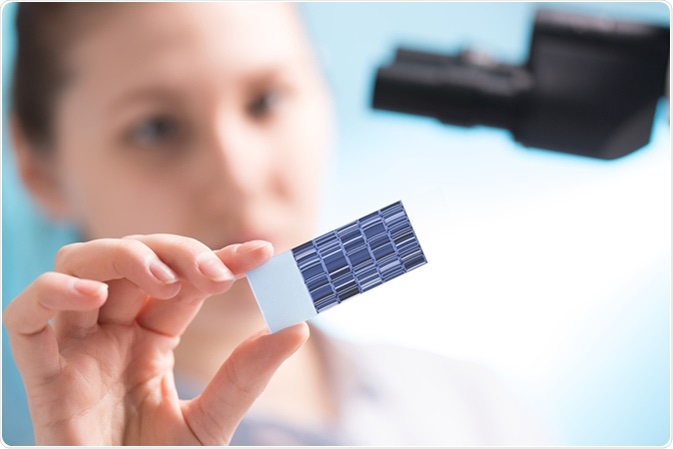Liquid chromatography - mass spectrometry (LC-MS) combines two approaches to separate and identify molecules or compounds present in a sample. High performance liquid chromatography (HPLC) separates components of a mixture, whereas mass spectrometry (MS) offers the detection tools to identify them. LC-MS, as a method for understanding biological molecules, has applications in both research and clinical diagnosis.
However, interpretation of the chromatograms generated by this method requires a fundamental understanding of how LC-MS works.

Chromatogram sequencing on slide. Image Credit: science photo / Shutterstock
LC-MS Method
Before HPLC was started being used widely, and still today, gas chromatography (GC) is often employed. The idea of coupling a technique for separating components of a mixture, such as HPLC or GC, with MS to analyze those components came in during the 1950s.
GC and MS were combined as GC-MS, a technique which is still commonly applied in clinical biology to screen the complex mixtures for identification of known substances, for example, testing for drugs in urine. LC-MS was developed later, during the 1980s. The lag in combining the two approaches was due to initial difficulties with the MS ion source and the liquid stream of the HPLC. The solution to this problem and subsequent viability of LC-MS earned John Fenn the Nobel Prize.
LC-MS begins with the HPLC, wherein a liquid is passed through a column. In this column, components are separated based on hydrophobic interactions, ion exchange, or other variable characteristics. HPLC alone cannot be used for identification, because different molecules can share so-called retention times.
The retention time is the time taken for a solute to pass through the column. This property can be shared among several components of one mixture, which is why MS methods are applied. The chromatogram yielded from this shows the retention time by the intensity (amount of component present).
Once separated, the components are converted to an ionized state. MS uses the mass to charge ratio as a characterizing factor to identify components, so the next step involves separation of components based on this.
Mass to charge ratio is more specific to a particular molecule than the retention time in HPLC, that is why MS is employed. Analyzers of mass to charge differences, just like the separation technique in HPLC, can differ, including analyzers such as quadrupole, time of flight, and ion trap.
The emerging ions are then counted by a detector. The resulting MS spectrum shows the mass to charge ratio plotted against the peak intensity.
Interpreting the Chromatograms
The chromatograms show components as functions of their retention time and mass to charge ratio by the mass relative abundance, meaning the total output from a full LC-MS is a graph with two horizontal axes. The focus of the graph can be altered depending on the researcher’s goal.
The chromatogram does not change for an analyte, therefore it can often be used as a fingerprint for types of molecules.
This is typically done by looking at where the peaks of the retention time and mass to charge ratio are. Nowadays, most analyses of chromatograms are done computationally. This means that a software will compare generated chromatograms to known ones in order to identify the components, or store it as a newly discovered one.
There are several ways to ensure proper reading of the chromatograms. Given that the factors such as characteristics causing separation in LC, ionization methods, and the analyzers of mass to charge ratio can all vary, developing a global answer to accurate processing of chromatograms is hard. When LC-MS settings are applied to cover a broad range of compounds, a method called differential profiling, the steps for processing will move through stages.
Spectral filtering aims at removing noise in the data, thereby facilitating detection of peaks of interest. Noise reduction can also be optimized during LC-MS by using shorter columns with smaller particle sizes, among other methods.
Peak detection follows filtering, whereby peaks represent components or fractures of components. The peaks can be selected based on height or area they cover. Certain peak patterns can be identified by eye, by matching up the peaks present to the known ones. This can help determine what molecules are present, or how many atoms are present in the molecule.
Further Reading
Last Updated: Sep 19, 2018